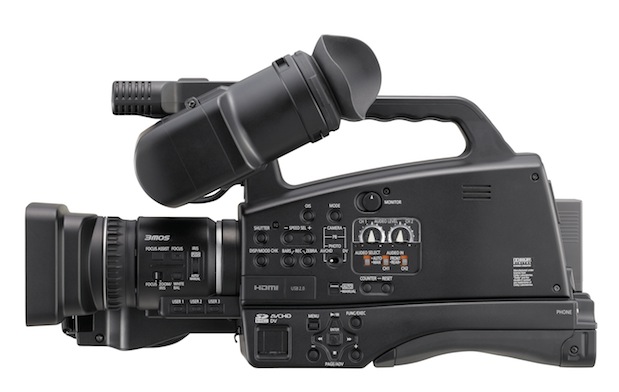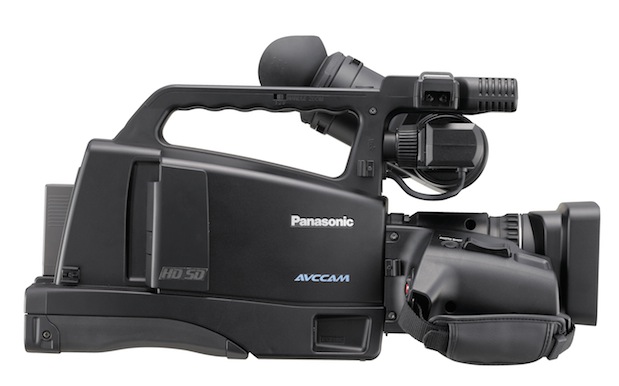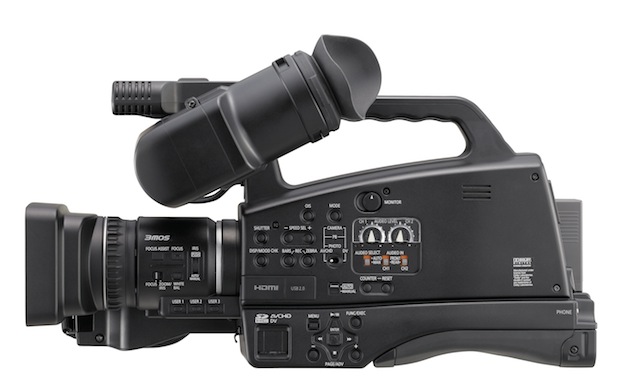
At NAB 2010, Panasonic announced the AG-HMC80, a bigger sister of the AG-HMC40, whose main improvements include a shoulder-mount shape/size, standard XLR inputs (as opposed to a US$300 option with the HMC40), and a manual focus ring (not available with the HMC40). Many ProVideo Coalition readers will already be familiar with Adam Wilt’s extensive review on the HMC40, and at NAB, Panasonic officials said that the HMC80’s optics, sensor, and recording modes are the same as with the HMC40. In this preview article, I’ll go into other differences between the HMC80 and its little sister, its European cousin, price, competition, and potential applications.
±60Hz version and 50Hz versions
As covered previously, Panasonic professional decides on a case-by-case basis whether new cameras they release are completely segregated (±60Hz only, 50Hz only, universal in European version, universal worldwide, or universal after paying for an upgrade). The official Panasonic press release for the AG-HMC80 only refers to 60Hz modes (which are the same as with the AG-HMC40, which only offers ±60Hz modes). The press release for the AG-HMC81 (for the 50Hz market) strangely also only refers to ±60Hz modes, which is almost certainly a collection of typographic errors. Since the 80/81 cameras are expected to be delivered in September 2010, it may be until October that we know the hard cold facts. For now, I would count on the HMC80 having ±60Hz modes exclusively, and the HMC81 having 50Hz modes exclusively, matching the current 40/41. If I become happily surprised from any official Panasonic source to the contrary who writes to me indicating that one or both will be universal -like the HMC151- (or upgradeable to universal), I will update this.
Standard definition
Unlike the HMC150/HMC151 and HMC40/HMC41 (which only offer 720p-HD and 1080i/p-HD modes), the HMC80/HMC81 also offer standard definition modes. If the assumption I made in the above section is correct, then the HMC80 will offer 720×480-type standard definition modes to coincide with NTSC, while the HMC81 will offer 720×576-type modes to coincide with PAL.
The right side panel reveals the fact that the HMC80/HMC81 can record either SD or HD.
Feature differences compared with its little sister
So far, I know that the HMC80/HMC81 have the advantages of shoulder-mounted design, standard XLR inputs, and manual focus ring, as well as standard definition recording. Unlike the HMC40/41, which have their optional XLR inputs up front on the top, the HMC80/HMC81 have them at the bottom rear. I will update this if and when I discover any other difference(s).
Price/comparison with its little sister
In the USA, the AG-HMC40 has a list price of US$2295, plus US$300 for the AG-MYA30G XLR audio adapter, which adds up to US$2595. According to the official Panasonic press release, the AG-HMC80 will have an official list price of US$2895, which is US$300 more per camera than the list price of the HMC40 with the AG-MYA30G. This is a very reasonable difference in price if you prefer the larger-sized shoulder mount for any reason. However, if you are planning to use the camera exclusively for live production through a video mixer (“switcher”) on a tripod, and were not planning to run any audio through the camera (and therefore have no technical reason to purchase the optional AG-MYA30G), then the difference in price will be US$600 per camera. On the other hand, some clients with whom I have discussed this after NAB have already said that they’d spend the extra money just for the physical “showoff” factor of the larger camera with their clients. Others will justify the price difference just for the manual focus ring.
Price/comparison with other brands
The closest JVC pro model is the GY-HM100 at US$3995 list price, but is not shoulder-mounted. The closest Sony pro model is the HVR-HD1000U at US$1950 list price, although it offers no 720p modes, or any 1080 progressive modes. Sony pro also offers the HVR-A1U at US$2699 list price, although it is not shoulder-mounted, offers no 720p modes, or any 1080 progressive modes. Sony consumer offers the HDR-AX2000 for US$3499 with XLR audio inputs (rare in a consumer model), which at least offers non-native 1080 progressive modes, although it offers no 720p recording modes, and it is not shoulder mounted. So the HMC80 and HMC81 are really alone in their price category, at least as of the publication date of this article.
Potential applications
I see the HMC80 and HMC81 filling the following needs, especially when budget is a factor:
- TV news and sports, especially thanks to its high framerate progressive modes, i.e. 720p50 and 720p59.94.
- Run and gun production, where the producer demands a shoulder-mount design, an electric zoom, and onboard XLR audio inputs without fussing with 3rd-party adapters or a separate audio recorder.
- Live multicam production, where genlock is not required.
Rear view, with viewfinder closed.
Rear view, with viewfinder opened.
When I wrote my recent NewTek TriCaster TCXD300 review, I purposely neglected to include the HMC40/HMC41, since I wasn’t sure whether its continuous HDMI output would be free from a nagging, undefeatable menu (as some consumer models do). However, at NAB I saw that MONOGRAM was successfully using the HMC41 with their BCC/Broadcast Case product, so it’s safe to assume that the HMC80/HMC81 will be equally suitable. See my full article about the BCC, together with a comparison with the TriCaster TCXD300.
To my knowledge, Panasonic currently offers no mini-CCU for these cameras, the way Sony does with the EVI-HD1 and HXR-NX5 (the first NXCAM), both of which are covered for multicam use on page 2 of my TriCaster TCXD300 review, although low-cost remote zoom controls are available for the mentioned HMC cameras.
Because of the fact that these cameras have a live HDMI output capable of at least 720p50 and 720p59.94 (and possible 1080 modes over HDMI), they are also candidates for use with external recording with an AJA KiPro or a Convergent Design nanoFlash.
Panasonic’s AVCCAM incomplete native progressive modes
See the related article, Panasonic’s AVCCAM incomplete native progressive recording modes.
Adam Wilt’s AG-HMC40 review
Considering that the sensor and optics are so similar, you may enjoy Adam Wilt’s AG-HMC40 review here.
Allan T©pper’s articles, seminars, and audio programs
Get a full index of Allan T©pper’s articles and upcoming seminars and webinars at AllanTepper.com. Listen to his radio program TecnoTur, which is now available both in Castilian and in English, free of charge. Search for TecnoTur in iTunes or visit TecnoTur.us for more information.
Disclosure, to comply with the FTC’s rules
None of the manufacturers listed in this article is paying Allan T©pper or TecnoTur LLC specifically to write this article. Some of the manufacturers listed above have contracted T©pper and/or TecnoTur LLC to carry out consulting and/or translations/localizations/transcreations. At the date of the publication of this article, none of the manufacturers listed above are sponsors of the TecnoTur programs, although they are welcome to do so, and some are already sponsors of ProVideo Coalition magazine.


